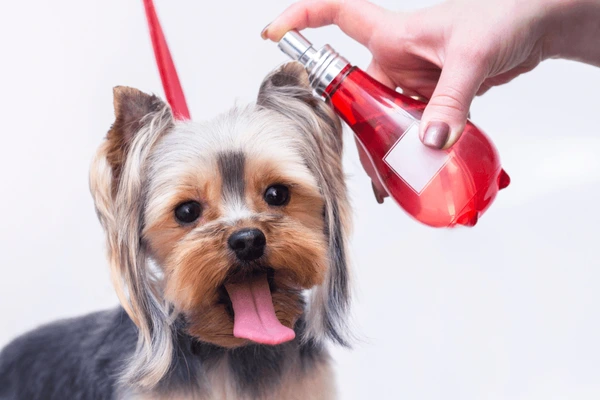The Growing Trend of Luxury Pet Products
With pet ownership on the rise and Americans projected to spend over $150 million on their furry companions in 2024, luxury items like designer dog perfumes are becoming increasingly popular. However, as tempting as it may be to indulge your pet with these high-end products, the more pressing question for dog owners and veterinarians alike is whether these perfumes and deodorizing sprays are safe for our canine friends.

How Do Pet Perfumes Work?
Dogs possess scent glands located throughout their bodies—particularly in their ears, paws, and anus. These glands produce secretions that can emit various odors, which can range from mild to strong and musty. Pet perfumes and deodorizing sprays are designed to mask or neutralize these natural odors. According to Dr. Terry Fossum, DVM, a board-certified veterinary surgeon, these products typically contain a blend of fragrances aimed at covering up smells that might be unpleasant to human noses.
While some odors, like the “corn chip” scent often found on a dog’s paws, are completely normal and do not indicate an underlying health issue, many pet perfumes claim to use safer odor-neutralizing compounds than those found in human perfumes. However, just because a product is marketed for pets does not mean it is entirely risk-free.
Benefits and Risks of Using Pet Perfumes
One advantage of pet perfumes is that they can make your dog smell more appealing. Additionally, certain fragrances, such as lavender, can have calming effects on dogs due to compounds like linalool, which may promote relaxation. However, it’s essential to be aware of the potential health and safety risks associated with these products.
Strong fragrances can overwhelm dogs, potentially interfering with their ability to recognize and communicate with their environment. Symptoms of distress may manifest as panting, pacing, or yawning. In severe cases, intense scents can disorient dogs, making it difficult for them to navigate their surroundings.
Moreover, dogs with existing skin conditions or sensitivities are at a higher risk of skin irritation and allergic reactions. The inhalation of harsh chemical compounds can also pose respiratory risks, especially for dogs suffering from asthma or bronchitis. If ingested, perfumes may lead to gastrointestinal issues such as drooling, vomiting, or diarrhea.
Another concern is that masking odors with perfumes can hinder veterinarians’ ability to diagnose certain skin conditions that produce distinct smells.

How to Use Pet Perfumes Safely
If you choose to use pet perfumes or deodorizing sprays, follow these guidelines for safe application:
- Use Sparingly: Apply the product in moderation, focusing on areas away from your dog’s face and nose.
- Apply by Hand: For better control over the amount used, spray the perfume onto your hands and then rub it into your dog’s fur, avoiding sensitive areas such as the face, eyes, ears, and genitals.
- Monitor Your Dog: Watch for signs of discomfort after applying perfume. If your dog appears irritated or uneasy, promptly wash off the product.
- Limit Frequency: Limit the use of pet perfumes to once a week at most and only when necessary.

Ingredients to Avoid
Many pet perfumes contain ingredients typically found in human fragrances, such as ylang-ylang. While aromatic, ylang-ylang can be toxic if ingested, and its strong scent can overwhelm your dog’s sensitive nose. Always apply such products in areas where your dog cannot sniff or lick them.
Even products marketed as “natural” can pose risks. Essential oils like tea tree oil are unsafe for dogs and can lead to poisoning. It’s best to avoid perfumes with artificial fragrances, alcohol, and parabens, which are used as preservatives in many cosmetics.
Before purchasing any pet perfume, carefully check the ingredient list and consult your veterinarian to ensure the product is safe for your dog. If your dog has a persistent odor, consider increasing the frequency of baths, regular brushing, and dental care instead of relying on perfumes.

